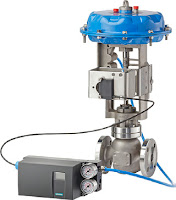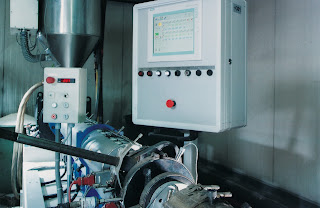Polyester is very popular because it is a light, soft, flexible, low-maintenance material that keeps you warm. Making it this way poses diverse challenges to PET producers.
A chemical plant specializing in producing PET was looking for a solution to reduce the waste resulting from product variance. The factory produces 25,000 tons of polyester annually, which is then provided to other manufacturers to produce a vast range of end products.
 |
The SITRANS FC430
monitors the glycol flow. |
This vast range requires different PET grades, which are achieved by slight variations in the synthesis procedures. In order to investigate possible options to upgrade their primary processing, understanding the complete process is vital. In the case of PET production, this process starts with mixing three key ingredients – PTA and IPA powder along with glycol liquid – in specific ratios to make a paste.
These source materials are stored in stainless steel bins with a volume of 2649 ft3. Rotary feeders move the mate- rial from these bins to a batching vessel along with glycol to make the polyester paste. The batching vessel is agitated to ensure that the mixture is always consistent. Monitoring tank levels, precisely controlling the dosing, the efficient use of raw materials and ensuring a consistent mix are the key parameters
 |
| SIWAREX WP251 |
when it comes to improving the primary processing. When Siemens designed a new system for the chemical plant from the bottom up, the Siemens S7-1200 PLC controller was the first product that was installed to set up a compact and flexible automation solution, which keeps track of the key parameters and the process efficiency.
Don’t get mixed up during mixing
Each raw material bin is mounted on Siwarex WL280 ring torsion load cells to achieve optimum weighing accuracy. These load cells are connected to two Siwarex WP251 weighing modules, which are specifically designed for batching applications. The advantages of this solution are that the WL280 load cells feature a C3 class rating for accuracy as well as an IP68 rating for protection against dust and direct high-pressure cleaning – ideal for handling powder materials such as PTA. In connection with the Siwarex WP251, a customer-specific application was engineered with a resolution of up to +/- 4 million parts.
 |
| SITRANS TS500 |
The glycol as the liquid component in this process is monitored by a Sitrans FC430 coriolis mass flowmeter providing a 4-20 mA output, which varies based on the flow rate of the material. This signal is fed into an analog S7-1200 input module. A Sipart PS2 positioner controls the valves to regulate the flow rate. In such flexible processes as this one, the operator individually sets the setpoint for total production. At the field level, this flexibility is achieved using Sinamics variable frequency drives, which independently adjust the flow rate of each material. To close the loop, the discharge rates from the raw material bins are monitored by the WP251. The output is then processed by the S7-1200 controller, sent through an analog module to control the Sipart PS2 positioner – which in turn allows more or less glycol to flow into the batching vessel. The downstream Sitrans FC430 flow meter additionally verifies the flow rate to ensure a high-quality mix.
How powder and liquid become PET
 |
| Pointek CLS200 |
The temperature of the paste is another crucial factor when it comes to producing high-quality PET. If the agitation causes too much heat, the whole mixture could be lost, causing unwanted waste. In this configuration, a TS500 controls the temperature to the optimum level. To further cut down on product loss, a Pointek CLS200 capacitance- based switch acts as a backup device to ensure that the material discharges completely, and does not build up or overflow. Its high frequency oscillation makes it insensitive to product buildup, therefore guaranteeing reliable level monitoring in the PET paste vessel. For integrated control and alarm management, the level switch is connected to the S7-1200 controller. With 13 sensors, 2 VFDs, 3 geared motors, 4 modules and 1 HMI installed and connected to the control system, the plant managers reap the benefits of a comprehensive portfolio from one supplier. The new equipment is reliable and efficient and – together with the DCS solution – offers excellent process and data control.
Less material waste and reduced downtimes
 |
| SIPART PS2 |
Where did this leave the chemical company? After the equipment had been running for 3 months, the first estimates were made as to whether the initial goals of reduced waste and increased efficiency had been met. The result: plant efficiency had increased by 27 % due to the reduced material waste and product loss. Further, the more reliable process measurements and diagnostics help the company to service their equipment on a preventive basis instead of a reactive one, resulting in reduced downtimes and in- creased reliability.
 |
| Simplified diagram showing the customer’s process. |
So the next time, you put on your running gear, take a sip out of a plastic bottle or attach your safety belt, maybe you will remember the effort that goes into producing the PET that is needed to manufacture these types of products. By the way – they have another important characteristic in common as they can be completely recycled.
Ives Equipment
877-768-1600
https://ivesequipment.com






